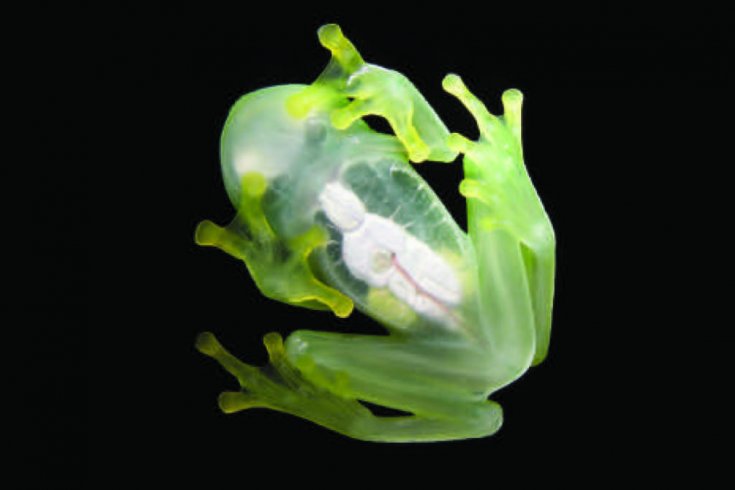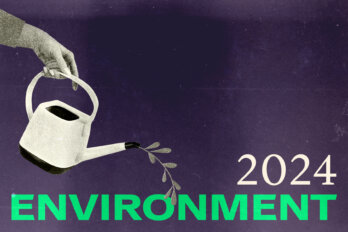
siquerres—Four of us are trying to navigate the steep trail in our slick, mud-covered rubber boots. Four long flashlight beams dance in the dark over rain-splashed fern fronds, palm and bromeliad leaves. “OK, there, see that??” A beam alights on a small blob atop a massive leaf way off the path. One pair of boots plunges deftly into the forest. One set of hands returns and opens to reveal a tiny lemur leaf frog named, according to the book Leaf-Frogs of Costa Rica, “for its behavior of walking among the foliage similar to the monkey-like lemurs of Madagascar.”
The author of the book and the man who holds the frog in his hands—as well as, quite possibly, the fate of the entire species—is thirty-one-year-old Brian Kubicki, a native Minnesotan who has devoted his life to researching, writing about, and preserving the amphibians of Costa Rica. This year, Kubicki published Glass Frogs of Costa Rica, a definitive collection covering the title species as well as other amphibians, including the spectacular golden toad. First identified in the country’s Monteverde cloud-forest reserve in 1967, the golden toad went into abrupt decline twenty years later, and not a single one has been seen since 1989. Working without government support, Kubicki is trying to save other species from the same fate.
“You guys are lucky to see him,” he says, gently splaying the lemur leaf frog’s tiny hands. Kubicki notes its distinguishing characteristic: no inter-digital webbing. Later, holding an even smaller dink frog, he marvels at the shiny pinpoints (“like nail polish!”) at the end of its toes.
It’s easy to understand why a researcher would develop a protective fondness for these wildly colourful, diminutive frogs: with their large eyes, wide mouths, and plump arms, they are cute. Kubicki had talked up the leaf-walking lemur frog as a possible grand finale to our late-evening slog through the rainforest. Nonetheless, we are equally impressed with the eighteen other frog species we encounter—among them the dazzling red-eyed leaf frog, the aptly named splendid leaf frog, and the astonishing glass frogs, which are brilliant green on the front and so translucent on the underside you can see their internal organs. Not all are tiny: one smoky jungle frog, the colour of burnished copper and the size of a pumpernickel loaf, hunkers down beside a pond in a clearing, the better to slurp up unlucky leaf frogs. Cat-eyed snakes, another predator species, are also around, slender coils looped in the greenery. We are fortunate not to encounter any fer-de-lances—nasty and not-uncommon vipers that lurk near frog-filled ponds. Their fangs, Kubicki warns us, can pierce right through rubber boots. It’s amazing how information like that perks up the dance of our flashlight beams.
It’s rush hour and hardly tranquil in the rainforest as we climb up and down the slippery trail in a steady downpour, listening for the frogs’ distinctive peeps, buzzes, diks, chucks, peets, creek-eeks, wonks, and wrauks. Kubicki can easily distinguish their voices thanks to hundreds of nights spent recording and counting frogs and toads, fuelled by flasks of “jungle cappuccino,” a jolting concoction made with instant coffee and sweetened condensed milk. Although the forest sounds cacophonous to us, Kubicki tells us it’s a quiet night. When we finally leave the forest, drenched, ducking under gargantuan palm leaves that could shelter the entire cast of Lost, we’re happy to avail ourselves of the one luxury item a struggling amphibian researcher allows himself: a clothes dryer.
Kubicki has lived in Costa Rica for the past eight years and is the sole proprietor of the Costa Rican Amphibian Research Center, which consists of a swath of rainforest on the country’s eastern Caribbean slope, in the hills above the town of Siquerres. At the Center, which is also Kubicki’s home, you’ll find him in the lab tending to frogs and toads or puttering in the greenhouse, where he collects and grows specimens of the region’s rare miniature orchids, tree species, and carnivorous plants. You might also spot him walking around his thirty-five-hectare property, checking out the tubs and ponds he’s introduced to help dwindling species breed.
These tubs and ponds will help Kubicki avoid the scenario that unfolded when the golden toad was identified as an endangered and rare species. The Costa Rican government placed strict regulations on study of the toad and prevented the establishment of captive-breeding programs. Now, the golden toad is simply gone. It was a case, says Kubicki, of “protecting a species to death.”
No one knows exactly why the golden toad and others are experiencing declines described as “catastrophic” by the recent Global Amphibian Assessment, which gathered the findings of five hundred scientists in sixty countries, but the usual suspects are the four apocalyptic horsemen of climate change, habitat decline, pesticide exposure, and disease—“separate but related threats,” says Kubicki.
So far, Kubicki has found fifty of the nearly two hundred amphibian species that can be found in Costa Rica on his property. He says he’d like to buy another band of farmland surrounding his as a buffer against development—luxury-condo billboards are sprouting up in Costa Rica as fast as some of its most unique species are becoming endangered.
“Brian is doing more for amphibian conservation as an individual than many institutions,” says Ron Gagliardo, amphibian conservation coordinator at the Atlanta Botanical Gardens, which works with Kubicki on his centre’s breeding program. Too often, Gagliardo says, institutional red tape holds up conservation efforts, making an independent like Kubicki all the more valuable.
On the brow of a hill overlooking the forest sits the spacious new earthquake-proof house where Kubicki and his Costa Rican wife live. He’s in this for the long haul, clearly, but one senses the stress in Kubicki’s rapid speech and daily multitasking, a sense of urgency about documenting and preserving species before it’s too late. Captive breeding means more frogs to put back into the environment—but there has to be an environment to put them back into. It’s Kubicki’s field research, says Gagliardo, all those wet nights slogging through the rainforest, wired on jungle cappuccino, watching, listening, and counting, that will really tell us what’s going on, and give amphibians, and the places they need to live, a fair shot at survival.•
—Moira Farr



